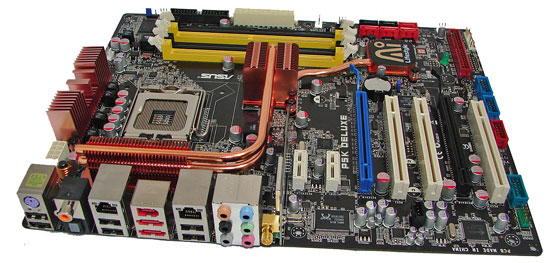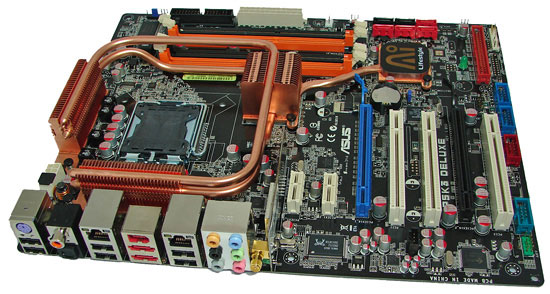Intel P35: Intel's Mainstream Chipset Grows Up
by Gary Key & Wesley Fink on May 21, 2007 3:45 PM EST- Posted in
- CPUs
ASUS P5K & P5K3 Deluxe Features
| ASUS P5K Deluxe and P5K3 Deluxe | |
| Market Segment: | Enthusiast - $229.99~$249.99 |
| CPU Interface: | Socket T (Socket 775) |
| CPU Support: | LGA775-based Pentium 4, Celeron D, Pentium D, Pentium EE, Core 2 Duo, Core 2 Extreme |
| Chipset: | Intel P35 MCH and Intel ICH9R |
| Bus Speeds: | Auto, 200 ~ 800 in 1MHz increments |
| Memory Speed: DDR2 | Auto, 200 FSB - 667/800, 266 FSB - 667/800/889/1067 333 FSB - 667/800/833/1000/1067/1111/1333 |
| Memory Speed: DDR3 | Auto, 200 FSB - 800, 266 FSB - 800/889/1067 333 FSB - 800/833/1000/1067/1111/1333 |
| PCIe Speeds: | 100MHz~150MHz in 1MHz Increments |
| Core Voltage: | Auto, 1.1000V to 1.7000V in 0.0125V increments |
| CPU Voltage Damper: | Auto, Enable, Disabled |
| Core Voltage Reference: | Auto, .63x, .61x, .59x, .57x |
| CPU Clock Multiplier: | Auto, 6x-12x in 1X increments if CPU is unlocked, downwards unlocked, Core 2 Duo |
| DRAM Voltage: DDR2 | Auto, 1.80V ~ 2.55V in various increments |
| DRAM Voltage: DDR3 | Auto, 1.50V ~ 2.20V in various increments |
| DRAM Timing Control: | Auto, 9 DRAM Timing Options |
| Transaction Booster: | Auto, Enable 0/1, Disabled 0/3 |
| NB Voltage: | Auto, 1.25V, 1.40V, 1.55V, 1.70V |
| FSB Voltage: | Auto, 1.2V, 1.3V, 1.4V, 1.5V |
| Memory Slots: | Four 240-pin DDR2 DIMM Slots Dual-Channel Configuration Regular Unbuffered Memory to 8GB Total |
| Expansion Slots: | 2 - PCIe X16 (1x16, 1x4 electrical for CrossFire or Multi-GPU) 2 - PCIe x1 3 - PCI Slot 2.2 |
| Onboard SATA/RAID: | 6 SATA 3Gbps Ports - ICH9R (RAID 0,1, 10, 5) 2 e-SATA 3Gbps Port - JMicron JMB363 |
| Onboard IDE: | 1 ATA133/100/66 Port (2 drives) - JMicron JMB363 |
| Onboard USB 2.0/IEEE-1394: | 10 USB 2.0 Ports - 6 I/O Panel - 4 via Headers 2 Firewire 400 Ports by Agere FW322 - 1 I/O Panel, 1 via Header |
| Onboard LAN: | Marvell Gigabit Ethernet 88E8056 - PCI Express Gigabit Ethernet controller Realtek RTL8187 PCI Gigabit Ethernet controller |
| Onboard Audio: | ADI 1988B - 8-channel HD audio codec |
| Power Connectors: | ATX 24-pin, 8-pin EATX 12V |
| I/O Panel: | 1 x PS/2 Keyboard 1 x WiFi Port 2 x e-SATA 1 x S/PDIF Coaxial/Optical - Out 1 x IEEE 1394a 1 x Audio Panel 2 x RJ45 6 x USB 2.0/1.1 |
| BIOS Revision: | v.0304 |
| Board Revision: | v1.00 |
ASUS has loaded down this board with a wide array of options that includes their WiFi-AP Solo wireless network solution, dual Gigabit LAN, ADI AD1988B HD audio codec with improved circuitry, and the complete AI Lifestyle suite. The BIOS is fairly comprehensive and is enthusiast oriented. The two most important features we used during testing are the Transaction Booster option that on average improved unbuffered memory scores and latency by 4%~7% along with the CPU Voltage Damper setting that greatly reduced Vcore droop. We noticed under load testing with our QX6700 that average Vcore droop was around .04V and with CPU Voltage Damper enabled the average VCore droop hovered around .02V.
ASUS P5K Deluxe Layout and Features
 |
| Click to enlarge |
ASUS did a really nice job in the layout of this board as all features on the board except for the clear CMOS jumper are easily reached. This board features an eight-phase power regulation system and 100% use of conductive polymer aluminum capacitors that provided excellent stability during testing at stock and overclocked speeds. During our overclocking tests we found the passive heatpipe system worked well but additional airflow was required to ensure stability during overclock testing.
The board installed easily into our Cooler Master CM Stacker 830 case and cable management was very good for power, optical, and hard drives. Our only concern was that two out of six SATA connectors were partially blocked when installing an 8800 GTX. The ports could still be used with an angled SATA connector, but it seems only standard SATA cables are included in the packaging. Our larger heat sinks did fit on this board, but there was not much space left around the CPU area after installation. We will go in depth about the board and its features in our P35 roundup before Computex.
ASUS P5K3 Deluxe Layout and Features
 |
| Click to enlarge |
The P5K3 Deluxe is based on the same board design as the P5K but includes a wrap around heatpipe system that provided a slight benefit during overclock testing provided airflow was adequate. We saw an average temperature reduction of about 2C when measuring the MCH under load when compared to the P5K board. However, the drawback is that installation of a large heatsink is cumbersome with this design. Our current inventory of heat sinks worked but be prepared for some minor cuts when installing them. Of course, the real news about this board is support for DDR3 memory and some interesting test results as we will see shortly.










58 Comments
View All Comments
Gary Key - Tuesday, May 22, 2007 - link
X38 is basically ready, going through some fine tuning now... I understand it will be held until after the 1333CPUs are launched and DDR3 availability is a little more widespread/cost effective. I expect late August right now, but you never know with Intel. ;-)JarredWalton - Monday, May 21, 2007 - link
Technically Q3 is any time between July 1 and September 30, but if they're saying Q3 right now it probably means some time in August at best.gigahertz20 - Monday, May 21, 2007 - link
I applaud ASUS for only including 1 legacy connection on their P5K series, and not 4 like Gigabyte has chosen to do for their P35 board. Death to legacy connections!I mean really, why even include those damn legacy ports. The enthusiast that buys one of these boards will not be using them, they are a waste of space. Instead of having them, they should replace them with more USB ports or something useful.
JarredWalton - Monday, May 21, 2007 - link
I still have a parallel based laser printer that works fine for what I need, and I'm quite happy using it until it dies. There are also people that use serial devices that cost a lot of money. I don't think every board needs legacy support, but it's good that there are still options for people that *need* certain legacy devices. I've got several KVM switches that won't be useful if PS/2 ports disappear. :(yacoub - Monday, May 21, 2007 - link
Don't they offer USB or eSATA to serial/parallel convertors for those sort of situations? :)JarredWalton - Monday, May 21, 2007 - link
Sure, but I haven't had the need to try one yet. :)Truth be told, my printer has a USB port, but it behaves very poorly using a USB connection. It's a Brother HL-1240, and if the printer isn't powered on when you boot, Windows won't see it unless you unplug it and plug it back into a different USB port. It just works better with LPT, and as I said for my needs it's sufficient. The way I figure it, having the ports there isn't hurting most people. I've never seen anything to indicate they hamper performance, and how many extra transistors are "wasted" on these ports? Maybe a few thousand? Heheh. 45M transistors on the P35 is a bit crazy....
For what it's worth, between mouse, keyboard, and my LCD (which actually has four USB ports and flash memory readers), I haven't had any need for more than four USB ports on a motherboard. But then, I've got too many PCs around anyway.
TA152H - Monday, May 21, 2007 - link
I agree with you, but for another reason.I don't like USB at all, because a few years ago I ran some tests, on motherboards ranging from MVP3 based to a KT880, and USB seems to have a negative impact on performance, particularly on memory, in many cases.
It doesn't make my keyboard work any better, or my mouse, and I'm not sure why I need it for those functions at all. PS/2 ports don't do it well enough? I'm not crazy about this one size fits all approach, especially when it comes with overhead. The current ports work fine.
USB is a crappy, bloated technology. I'm not sure the "S" should stand for "serial" at all, I think there is a better word that begins with S for it.
strikeback03 - Tuesday, May 22, 2007 - link
Wake me up when Bluetooth works over PS/2.Though one reason to still include PS/2 keyboard/mouse is that it is hard to screw up support for those in Linux kernels. Same can't be said about USB.
TA152H - Tuesday, May 22, 2007 - link
Wake me up when I need Bluetooth.You could implement Bluetooth easily if USB didn't exist, but you're missing the point anyway. When you have to use USB for stuff that is handled more efficiently by PS/2 ports, it's a bad thing. Or other ports. It adds no function for these devices, and comes with overhead. It's a bad idea, but of course Intel was in the mode of making as many things as possible use CPU power so they could keep selling their latest and greatest.
It's just a rehash of some dorky Apple stuff that most people here don't remember. The original MacIntoy didn't have any slots, and you'd attach stuff to some serial bus for expansion. Naturally, it didn't work out, and they had to add slots. At least they didn't get rid of slots for USB, they just made it bloated.
DigitalFreak - Monday, May 21, 2007 - link
Man, if the P35 boards are going to be around the $250 mark, I'm not looking forward to see the price on the X38 boards.... :-(